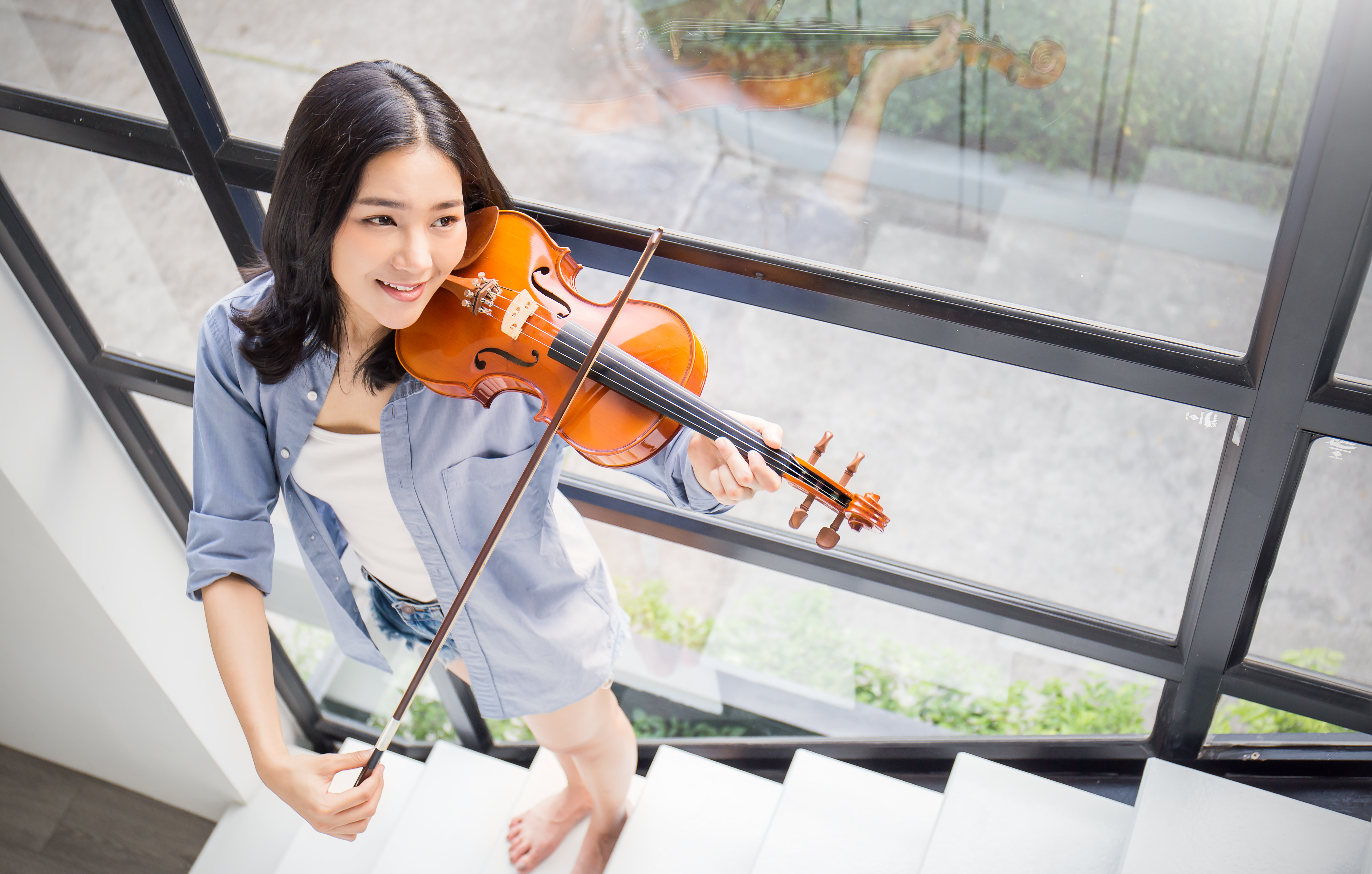The Wonderful World Violin
The violin is a great instrument to learn and has been around for centuries. Finding its origins in 16th century Italy, with other bow instruments such as the cello and viola. Coming to the exact date of the violin has been a challenge for contemporaries. Through paintings by italian painter Gaudenzio Ferrari, historians make an estimate that during the 1530s the violin was created, as his paintings is the oldest to depict such a three-stringed bowed instrument. Instruments like violins that use strings and a bow to create sounds were called “bowed stringed instruments” in the early days. The two earliest recorded violin craftsman were Gasparo di Bertolotti and Andrea Amati, both residing in Italy. These early craftsman set the standard for violins and shaped what violins would be to come for many years. While the earliest ever created violins are no longer around today, some of the works of these two craftsman are still around and are evident in many museum exhibits, such as “‘Kurtz’ Violin” by Amati found in The MET.
Historically the “violin” was played largely by upper class society or professional musicians, while middle to lower class people played the “fiddle” (informal). As these are actually the same instrument the difference was generally the type of music played. Luckily times and perceptions have changed as this is truly an instrument that can be enjoyed by all regardless of which name you use or music genre you prefer to play. While most of us will not become, or may not aspire to become a great and famed violinist we can still, however, enjoy all the rewards and pleasures of learning to play such a beautiful instrument. The following provides some great information and outlines some benefits that may surprise you.


Violin impact on your overall well-being

Health Benefits
Playing the violin correctly demands perfect posture which, not only helps with better control and fluidity, but also has tremendous health benefits such as contribution to core body strength,improves upper body strength, helps maintain a healthy spine and back, as well as many other benefits enjoyed with great posture.
You can get a bit of a work out as well! Playing the violin can burn up to 170 calories an hour which is similar to a leisurely one hour walk (enough to burn off one can of soda).
Studies show that playing the violin helps children overcome psychological disorders, relieve stress, and serves as an excellent emotional outlet.
Improved Focus and Cognitive Benefits
Studies indicate that violinists form more connections between the right and left sides of their brain. This is hugely beneficial as it drives better coordination between both hands which is transferable to other musical instruments and, presumably, any activity that requires two hand coordination.
Early introduction to learning to play the violin has shown to improve memory, non verbal reasoning, and attention span. Improvements are also evident in reading skills, speech, language skills and a variety of other cognitive functions. Researchers have further noted improved abilities in deciphering and integrating sensory inputs from touch, sight, and hearing to higher brain functions.
Lastly playing the violin can result in faster cognitive processing speeds. Interestingly Albert Einstein was known to play the violin as a brainstorming technique.
Social Benefits
Playing the violin can be a great way to expand your social group as well. It can help kids improve interpersonal skills as they practice with others as well as help improve communication skills during lessons and performances.
Regardless of age, interacting with peers with like-minded interests will not only help improve skill but can also result in positive impacts on self-esteem as well as a sense of social belonging.
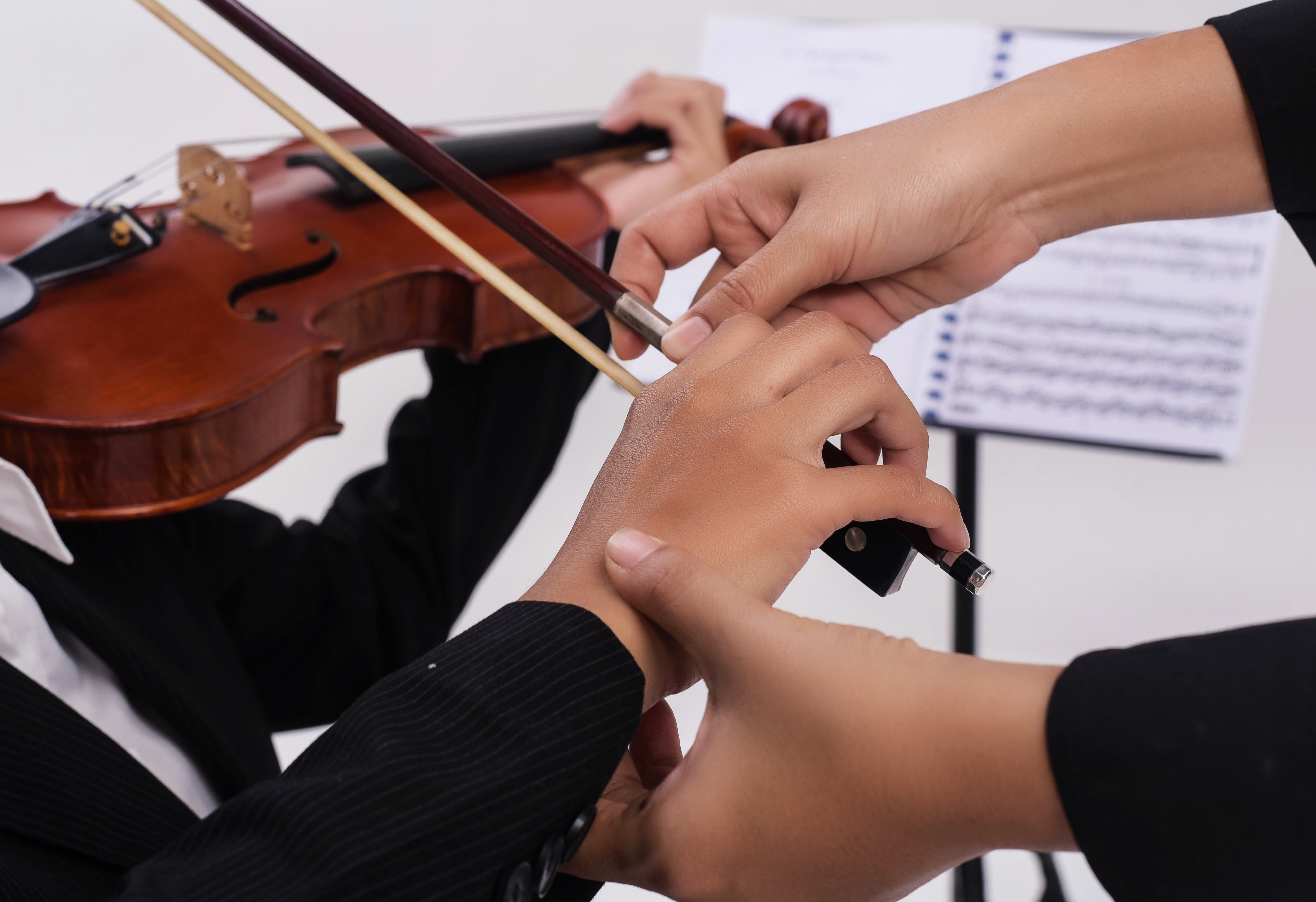

Classification and Components of the Violin
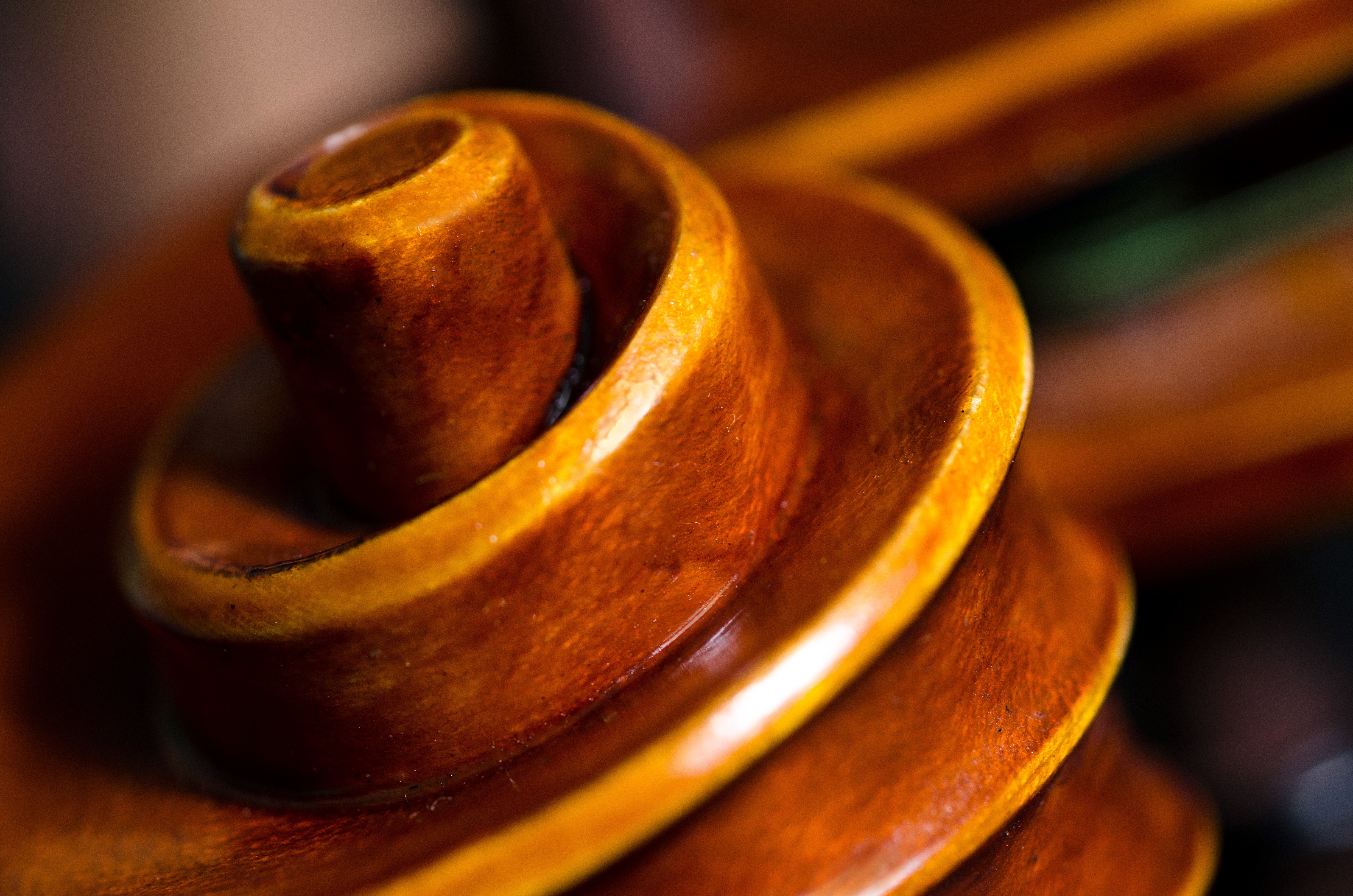
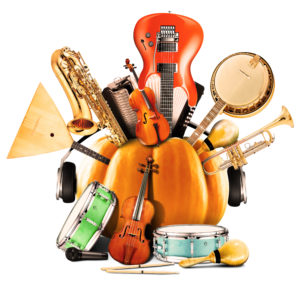
Many individuals in the western world think of musical instruments as belonging to the following groups: strings, percussion, brass, or wind. However, the Hornbostel-Sachs system is the most widely used classification of musical instruments and is divided into 4 main categories (with a 5th later added category):
- Idiophones
- Xylophone, triangle, etc.
- These are instruments that produce sound that comes from their own vibrations.
- Membranophones
- Drums, bongos, kazoos, etc.
- These produce sound by vibrating a membrane.
- Chordophones
- Piano, violin, guitar, cello, etc.
- These are instruments that produce sound by way of strings (such as bowing, plucking, strumming, striking, etc.)
- Aerophones
- Pipe organ, flute, oboe, saxophone, tuba, etc,
- These produce sound by vibrating columns of air.
- Electrophones
- Synthesizers, computer generated music, and electronic instruments, etc,
- These produce sound by electronic means (a somewhat disputed modern day addition to this classification)
The violin is part of the “chordophone” classification and is also informally known as a fiddle.
While it has undergone some subtle changes, the modern day violin design was perfected ~300 years ago and is widely accepted as being created in Italy in the 1500’s. It is a descendent of the medieval fiddle and rebec that evolved from the lyra.
See the diagram below for the components of the violin:
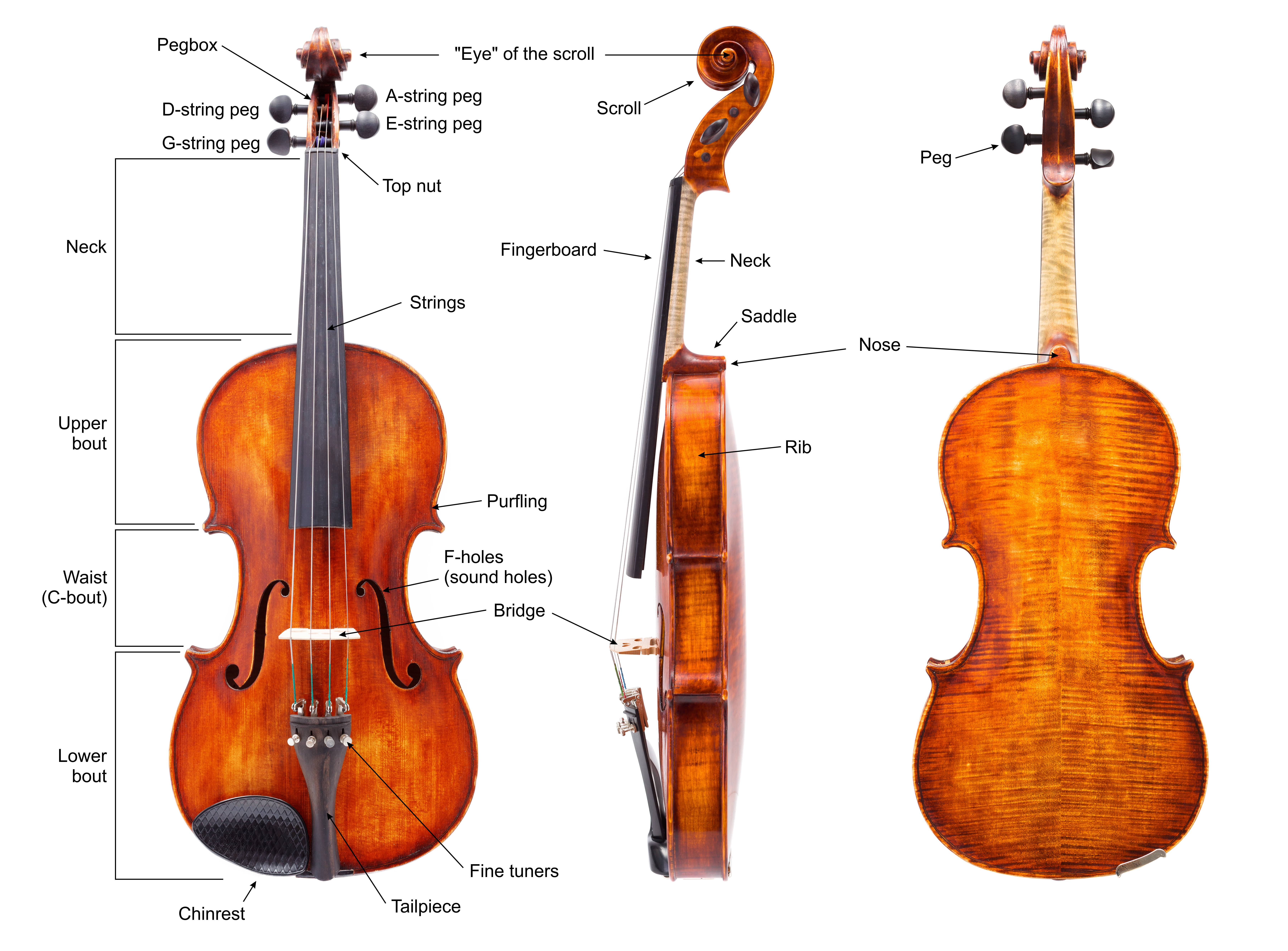
The body of the violin is composed of over 70 parts, which main components are:
- The Scroll – commonly made from maple wood – the intricate curve at the top of the violin
- The Peg Box – commonly made from maple wood
- The Tuning Pegs – commonly made from hardwood (boxwood, ebony, rosewood, etc.) – the strings are tuned using these
- The Strings – commonly made of steel
- The Nut – height guides for the strings as they enter the neck
- The Neck – commonly made from maple (older models may be ivory)
- The Fingerboard – commonly made from ebony wood and is glued to the front of the neck
- The Main Body
- The Belly (or table) – commonly made from spruce – two pieces glued together
- The Ribs – commonly made from maple – it surrounds the body attaching the belly and the back
- The Back Plate – commonly made from maple – usually two pieces glued together
- The Bridge – commonly made from maple – hold the strings in a latterly arched configuration
- The “F”or Sound Hole – allows air movement in and out of the main body
- The Sound Post – commonly made from spruce
- The Bass Bar – commonly made from spruce
- The fine Tuner – usually attached only to the E string – used for fine tuning
- The Tail Piece – anchors the strings
- The Tail Gut – holds the tail piece in place
- Purfling – a narrow decorative edging inlay on the top of belly (sometimes as well as the back plate)
- Blocks – part of the main body (top; corners; bottom)
- Saddle – at the start and at the end of the main body
Choosing a violin
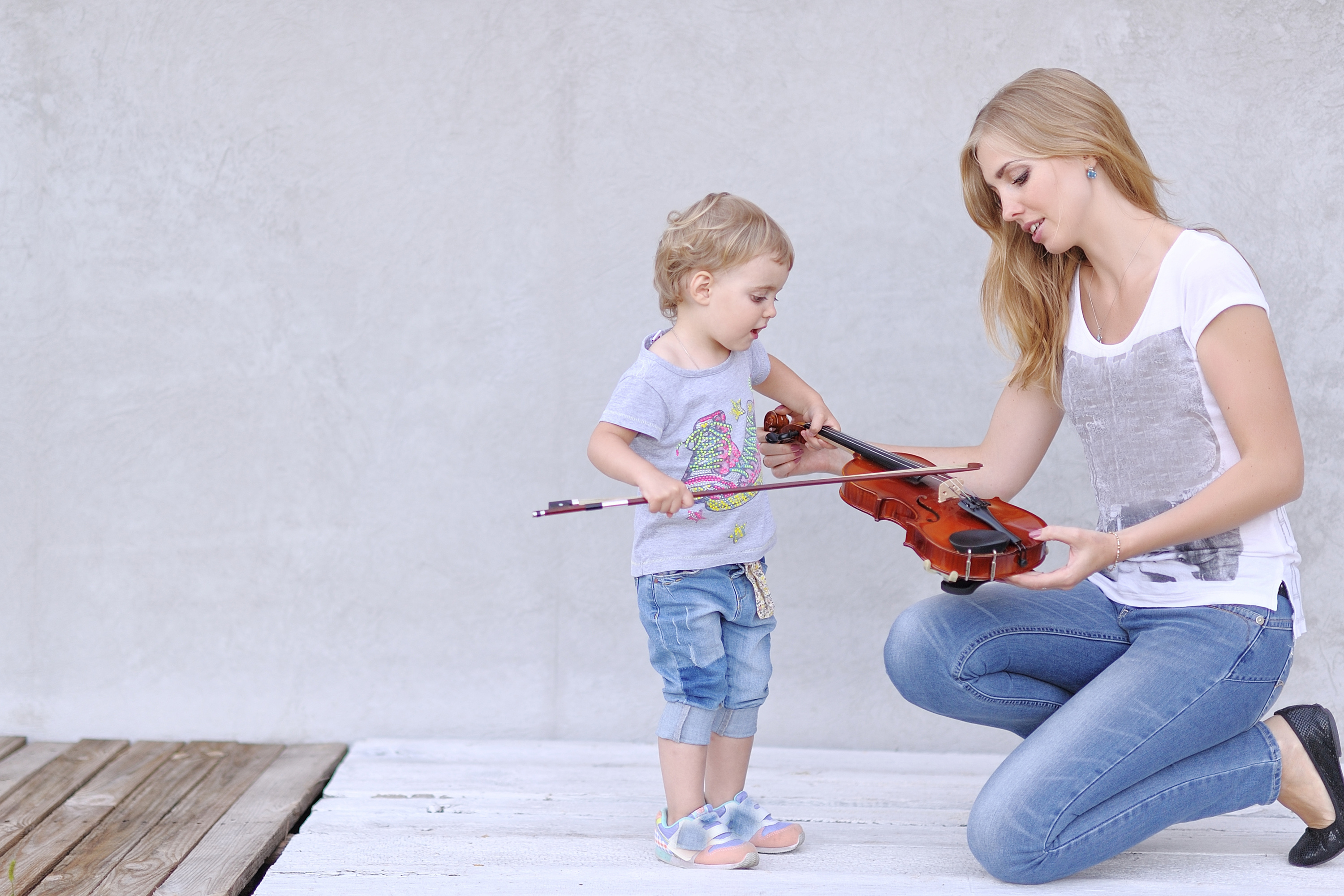
There are a number of factors to consider when deciding to purchase a violin. The first thing to consider is your intent. Are you buying it as a collector’s piece, for casual play, for serious play, to improve your skills, for frequent onstage performances, etc.? The intent and criteria for buying a violin will determine your budget. Generally speaking, the cost of a violin as a collector’s item or for stage performances is higher than one bought for casual playing.
Other considerations
Size matters - choosing a violin of incorrect size can result in chronic pain and strain and reduced learning progress.
- Size is determined by measuring from your neck to mid palm of your left hand. Age, size and shape of hands, body size and physical strength are also size determining factors.
- If you fall in between sizes it is always recommended to choose the smaller size to avoid strain. After you have determined the approximate size you need it is strongly advisable to buy a violin in person to try it out for fit, comfort, and size.
- Violins come in 8 sizes - 4/4 to 1/16 with 4/4 being the largest or full size.
The table below is a guide to determine approximate size based on neck to mid palm measurement and player age.

Owning a violin can be a great option but may not be preferable if you are anticipating up-sizing. In most cases there may be an option to rent a violin. This may be a better option if the student is unsure of the violin as a musical instrument choice. It may also be a good solution for a child that is going through a growing spurt that may quickly render a bought instrument as too small. If you own a violin it is important to remember that they are prone to integrity damage from heat, cold ,humidity and very dry conditions, so should be stored with these factors in mind. (As an example, friends from California have a family heirloom violin from Italy). If you store your instrument in your attic it is wise to consult with a reputable roofing company, such as the Best roofers in Los Angeles, to check for dampness or mold. These are key signs that your roof may need to be repaired or serviced, which may impact the integrity of your home and jeopardizes any thing stored in that area.
Quality and Craftsmanship
- Though looks matter, quality of the instrument is more important. Violin making was perfected a long time ago (over 300 years) and are constructed the same way today. They are commonly crafted from spruce and maple woods.
- As hand crafted violins are very costly, most intermediate and beginner players buy violins that have been created via a refined manufacturing which has a proven track record for making consistent effective instruments.
- When buying an instrument, look for symmetrical alignment, tight streamlined joints, as well as deep intricate carvings in the scroll. These are typically good indicators of higher quality instruments. If possible consult an expert and choose wisely within your budget.
Chin and Shoulder rests
- Chin rests should be chosen and positioned for best fit and comfort for the player.
- Shoulder rests should be chosen and positioned for best fit, comfort and and good posture.
Condition and age
- If buying used, look for excessive wear, cracks, damage, or missing parts and hear it played. Buyer beware is a great mantra anytime you buy anything used.
- Many experts argue that age improves the sound which is generally true provided the instrument is in great condition
Final considerations
- Hear it played to ensure you like the overall sound.
- Choose an instrument that aesthetically appeals to you without sacrificing quality.
- Ask the experts.
- When you do buy a violin get it fitted for your best comfort.
- Buy from a reputable seller. Establishments or shops that specialize in violins have a wider range of instruments, are the best choice to properly fit you with an instrument for comfort, and will offer the best advice in choosing an instrument overall.
